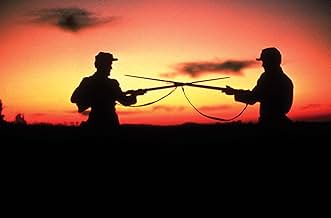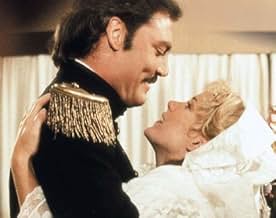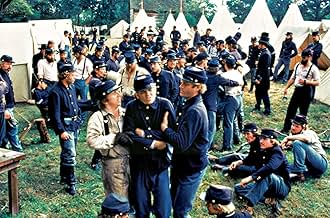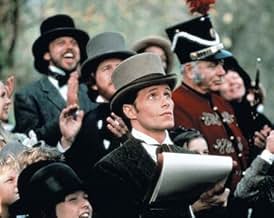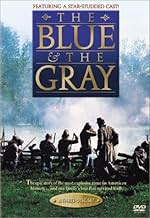Les États-Unis juste avant et pendant la guerre civile, vus à travers les yeux d'un artiste correspondant.Les États-Unis juste avant et pendant la guerre civile, vus à travers les yeux d'un artiste correspondant.Les États-Unis juste avant et pendant la guerre civile, vus à travers les yeux d'un artiste correspondant.
- Nommé pour 4 Primetime Emmys
- 2 victoires et 4 nominations au total
Parcourir les épisodes
Avis à la une
Back in the early Sixties there was a short lived television series called The Americans about two brothers who after their father was killed decided to fight on opposite sides in the Civil War. The whole business about brother against brother was no exaggeration. Right up to the very top with Mary Todd Lincoln having relatives who fought for the Confederacy, families were torn apart. The Blue And The Gray brings that aspect of the Civil War better than any other film made for the big or small screen since The Americans.
The families are the Geysers and the Hales related by the mothers, Diane Baker and Colleen Dewhurst being sisters. The Hales are from Gettysburg, Pennsylvania and the Geysers from what would now be West Virginia in and around Harper's Ferry and that's not even 100 miles distance. But the families are true to the sectional divide.
With the exception of John Geyser played by John Hammond who has made a black friend, a free man played by Paul Winfield who gets lynched for helping runaway slaves. He won't fight for a section that espouses slavery as a cause, but won't enlist in the Northern Armies either. A passing acquaintance played by Stacy Keach who gets himself involved in a lot of the major events of the war and married into the Hale family with Julia Duffy persuades Hammond to become a war correspondent and put his artistic talents to good use. Hammond becomes a pictorial chronicler of the seminal event of his generation.
Without ever losing control of the main story lines, what happens to the various Geyser and Hale family members, The Blue And The Gray captures the sweep and pageantry of the Civil War. Such real characters as Abraham Lincoln played by Gregory Peck and John Brown played by Sterling Hayden in what was his farewell performance do take a life of their own. With Peck we see a public and a private Lincoln which is true to the Lincoln mythology and yet quite a human character.
If I had to single out one performance that was especially touching it would be that of David W. Harper as one of the Hale brothers. The young man was eager to be the first to enlist in his town of Gettysburg, but he never made it to the battle that town became famous for. A not well covered portion of the war was the lack of sanitary facilities in army camps. Young Harper falls victim to dysentery and his performance will move you.
A few years later North and South covered a lot of the same ground that this particular mini-series did and it was as well done as The Blue And The Gray. I would recommend them both highly especially for young audiences to gain a real understanding of what the Civil War meant to the average individual/
The families are the Geysers and the Hales related by the mothers, Diane Baker and Colleen Dewhurst being sisters. The Hales are from Gettysburg, Pennsylvania and the Geysers from what would now be West Virginia in and around Harper's Ferry and that's not even 100 miles distance. But the families are true to the sectional divide.
With the exception of John Geyser played by John Hammond who has made a black friend, a free man played by Paul Winfield who gets lynched for helping runaway slaves. He won't fight for a section that espouses slavery as a cause, but won't enlist in the Northern Armies either. A passing acquaintance played by Stacy Keach who gets himself involved in a lot of the major events of the war and married into the Hale family with Julia Duffy persuades Hammond to become a war correspondent and put his artistic talents to good use. Hammond becomes a pictorial chronicler of the seminal event of his generation.
Without ever losing control of the main story lines, what happens to the various Geyser and Hale family members, The Blue And The Gray captures the sweep and pageantry of the Civil War. Such real characters as Abraham Lincoln played by Gregory Peck and John Brown played by Sterling Hayden in what was his farewell performance do take a life of their own. With Peck we see a public and a private Lincoln which is true to the Lincoln mythology and yet quite a human character.
If I had to single out one performance that was especially touching it would be that of David W. Harper as one of the Hale brothers. The young man was eager to be the first to enlist in his town of Gettysburg, but he never made it to the battle that town became famous for. A not well covered portion of the war was the lack of sanitary facilities in army camps. Young Harper falls victim to dysentery and his performance will move you.
A few years later North and South covered a lot of the same ground that this particular mini-series did and it was as well done as The Blue And The Gray. I would recommend them both highly especially for young audiences to gain a real understanding of what the Civil War meant to the average individual/
This miniseries shows the war primarily through the eyes of a Virginian who wants to witness history but cannot commit to either side of the conflict. His new-found profession of journalism allows him to participate as a neutral observer. He is surrounded by relatives and friends on both sides, and the miniseries shows events through their eyes as well.
The human side of the war is stressed, and it excellently portrays the toll the conflict took on families.
Many of the subplots are taken from Civil War historian Bruce Catton's final work, "Reflections On The Civil War." However, none of the people in the book, including the real John Geyser, appear in the miniseries. Rather, observations made in the book are woven around the main storyline as supplementary material.
Most of the military aspects of the miniseries are laughable and bear little resemblance to reality. Due to the miniseries being done on a miniseries budget we see none of the grand scale evident in "Gettysburg" or "Glory."
Stacy Keach gives a terrific performance as Jonas Steele, the Federal special operations agent. We see from his performance a little of the decentralized, more personalized ways in which intelligence gathering and other non-standard military operations were conducted in the nineteenth century.
The miniseries ran for over six hours on CBS in 1982, but well over an hour was cut for the two-cassette video release. Get the whole treatment if you can.
The human side of the war is stressed, and it excellently portrays the toll the conflict took on families.
Many of the subplots are taken from Civil War historian Bruce Catton's final work, "Reflections On The Civil War." However, none of the people in the book, including the real John Geyser, appear in the miniseries. Rather, observations made in the book are woven around the main storyline as supplementary material.
Most of the military aspects of the miniseries are laughable and bear little resemblance to reality. Due to the miniseries being done on a miniseries budget we see none of the grand scale evident in "Gettysburg" or "Glory."
Stacy Keach gives a terrific performance as Jonas Steele, the Federal special operations agent. We see from his performance a little of the decentralized, more personalized ways in which intelligence gathering and other non-standard military operations were conducted in the nineteenth century.
The miniseries ran for over six hours on CBS in 1982, but well over an hour was cut for the two-cassette video release. Get the whole treatment if you can.
I'm not going to nitpick this film because the wrong number of buttons are on a Civil War jacket nor am I going to criticize the fact that certain battles are presented out of chronological sequence, as some others have already pointed out.
But taken as a Civil War drama, THE BLUE AND THE GRAY ranks with the very best movies made about this era of American history and all of the performances are splendid. The human drama, both on the home front before the war and during the various battles, is portrayed very realistically, as are the graphic battle scenes.
The cast assembled does a wonderful job with characters that come alive. GREGORY PECK does well as Abraham Lincoln, although his make-up is a bit disconcerting and he was a bit too mature to play the role in the first place. But STACY KEACH and JOHN HAMMOND carry much of the film as the two leading characters who witness various aspects of the Civil War, seen through their eyes and experiences, and they are excellent.
The supporting cast includes vivid performances from LLOYD BRIDGES, COLLEEN DEWHURST, RORY CALHOUN, GERALDINE PAGE, RIP TORN, STERLING HAYDEN, DIANE BAKER. BRIAN KERWIN is excellent as the Hale brother facing battle for the first time, and the sequence with the balloon to observe the enemy from the air is full of tight suspense.
It may not be a perfect history lesson, but it is photographed beautifully in color (all of it filmed in Arkansas), has a fine musical score and is well worth the time it takes to unwind a very compelling story with characters any viewer can relate to.
I consider it one of the finest made-for-TV miniseries ever made.
But taken as a Civil War drama, THE BLUE AND THE GRAY ranks with the very best movies made about this era of American history and all of the performances are splendid. The human drama, both on the home front before the war and during the various battles, is portrayed very realistically, as are the graphic battle scenes.
The cast assembled does a wonderful job with characters that come alive. GREGORY PECK does well as Abraham Lincoln, although his make-up is a bit disconcerting and he was a bit too mature to play the role in the first place. But STACY KEACH and JOHN HAMMOND carry much of the film as the two leading characters who witness various aspects of the Civil War, seen through their eyes and experiences, and they are excellent.
The supporting cast includes vivid performances from LLOYD BRIDGES, COLLEEN DEWHURST, RORY CALHOUN, GERALDINE PAGE, RIP TORN, STERLING HAYDEN, DIANE BAKER. BRIAN KERWIN is excellent as the Hale brother facing battle for the first time, and the sequence with the balloon to observe the enemy from the air is full of tight suspense.
It may not be a perfect history lesson, but it is photographed beautifully in color (all of it filmed in Arkansas), has a fine musical score and is well worth the time it takes to unwind a very compelling story with characters any viewer can relate to.
I consider it one of the finest made-for-TV miniseries ever made.
I first saw this mini-series while in 5th grade history class as part of our studies on the Civil War, and I thought it was excellent. Many years later, I watched it again after finding a copy of the unabridged version (all 6+ hours of it!). I wasn't sure how it would stand the test of time (both as a 16 year old production and my own view of it, being 16 years older now) and braced myself for disappointment; however, I was very pleasantly surprised. The movie is as well done as I remembered it.
It's an engrossing movie that gives an honest, frank look at the inherent moral ambiguity of war, as well as the additional consequences of the Civil War, where "brother fought brother". Although the movie certainly takes dramatic license (the main character, a young Southerner who relocates to the north after becoming disillusioned with the cruel treatment of slaves, ends up stumbling across his staunchly pro-Confederate siblings as if they're all wandering around in the same town instead of an entire country!), you can see that the film makers took great pains to portray as many perspectives as possible, to show that each and every person involved in the war was human, with their own thoughts and feelings. I'm certainly no Civil War expert, but I thought it was a very balanced portrait. What's more amazing is that the mini rarely drags despite sometimes taking a leisurely pace during its 6 hour run-time. Although we all know how the movie with ultimately end, it keeps you interested in the lives of all the characters it introduces. I thought Stacy Keach did a particularly good job despite a few hammy lines. This mini-series should definitely be on any must-see list of war films.
It's an engrossing movie that gives an honest, frank look at the inherent moral ambiguity of war, as well as the additional consequences of the Civil War, where "brother fought brother". Although the movie certainly takes dramatic license (the main character, a young Southerner who relocates to the north after becoming disillusioned with the cruel treatment of slaves, ends up stumbling across his staunchly pro-Confederate siblings as if they're all wandering around in the same town instead of an entire country!), you can see that the film makers took great pains to portray as many perspectives as possible, to show that each and every person involved in the war was human, with their own thoughts and feelings. I'm certainly no Civil War expert, but I thought it was a very balanced portrait. What's more amazing is that the mini rarely drags despite sometimes taking a leisurely pace during its 6 hour run-time. Although we all know how the movie with ultimately end, it keeps you interested in the lives of all the characters it introduces. I thought Stacy Keach did a particularly good job despite a few hammy lines. This mini-series should definitely be on any must-see list of war films.
This is such a good movie mainly due to the lack of bias and multiple story lines which keep you hooked throughout the extensive length of the film. I thought that the film was, although of course not the greastest of civil war films, it definitely desearves nothing but good reviews. I saw this movie when i was visiting Utah with family and i had to live in a trailer with my brother and his friend for a few days and all we had was a DVD player and a few movies and some paper and pens. So when we finally decided to watch what seemed like a boring war movie...we never wanted to leave the trailer. Even when invited to go horse-back riding by some neighborhood girls whom my brother had been eyeing. the movie was completely captivating. Everyone should definitely see The Blue and the Gray at LEAST once.
Le saviez-vous
- AnecdotesSome filming took place at Prairie Grove Battlefield State Park in Arkansas. The film crew built a false side onto a historic building there, then blew it off for a special effect, assuring the State park officials that no harm would come to the building. The explosion was larger than promised, damaging the historic house's structure.
- GaffesWhen John Brown is hanged for the uprising at Harper's Ferry, the apple trees are in full blossom. John Brown was hanged on 2 December 1859.
- Citations
Abraham Lincoln: It's well known that the more a man speaks, the less he's understood.
- ConnexionsReferenced in Saturday Night Live: Drew Barrymore/Squeeze (1982)
- Bandes originalesRock of Ages
Lyrics by Augustus Montague Toplady (as Augustus M. Toplady)
Music by Thomas Hastings
Meilleurs choix
Connectez-vous pour évaluer et suivre la liste de favoris afin de recevoir des recommandations personnalisées
- How many seasons does The Blue and the Gray have?Alimenté par Alexa
Détails
- Date de sortie
- Pays d’origine
- Langue
- Aussi connu sous le nom de
- Die Blauen und die Grauen
- Lieux de tournage
- Sociétés de production
- Voir plus de crédits d'entreprise sur IMDbPro
Contribuer à cette page
Suggérer une modification ou ajouter du contenu manquant

Lacune principale
By what name was The Blue and the Gray (1982) officially released in India in English?
Répondre


